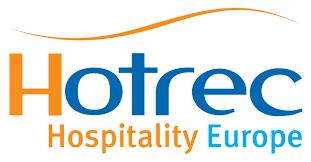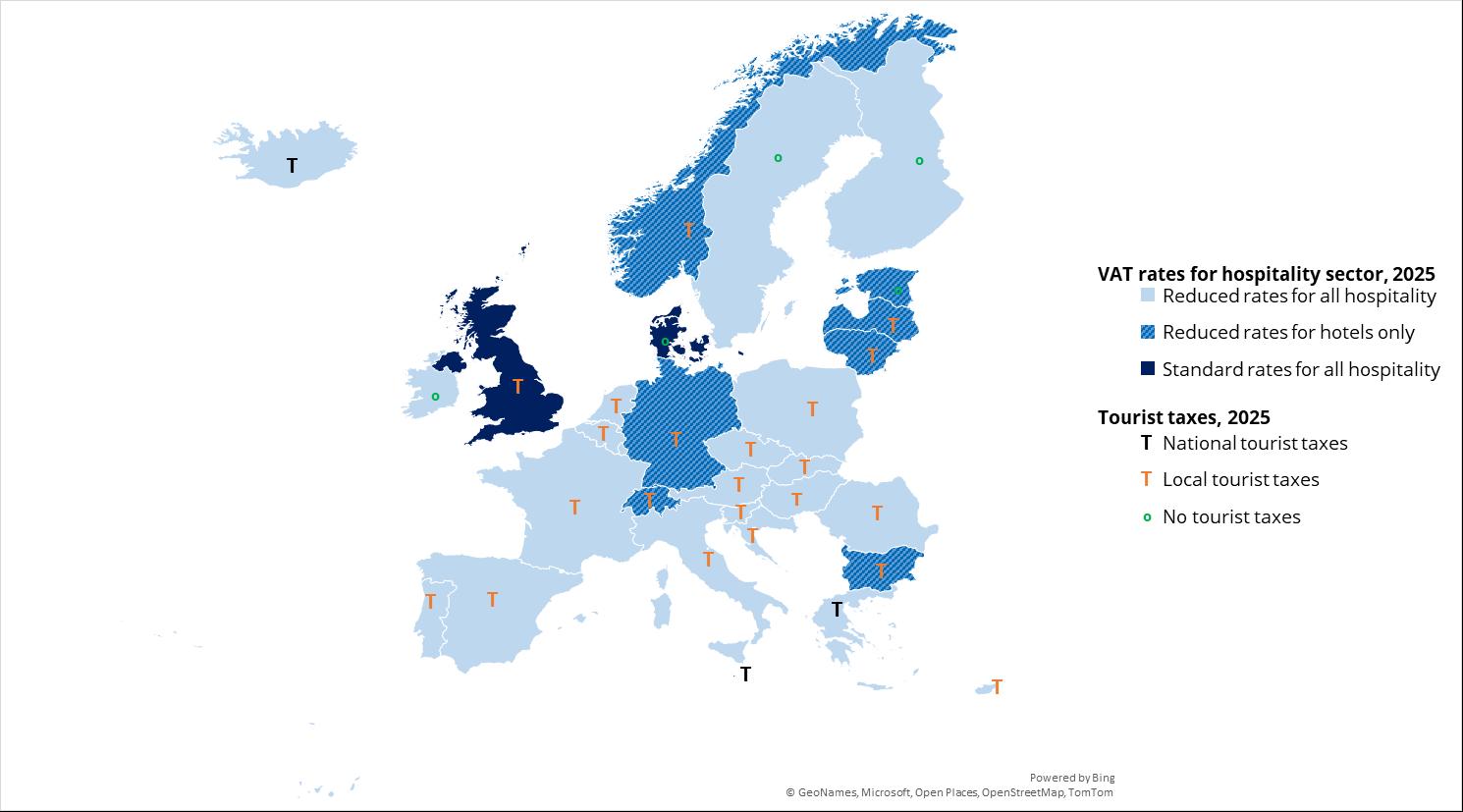




Executive Summary
Introduction – a crucial moment to assess taxation in the hospitality industry
Thepurposeofthisstudyistoreviewtheimpact of taxation on the hospitality industry. It was carried out for HOTREC and covers the 27 EU Member States as well as Iceland, Norway and the UK.
“Many national HOTREC members have identified increasing VAT rates and new / higher tourism taxes as a cause of negative impacts on their businesses.”
After describing recent developments and the relevant literature, the study assessed the effects of taxation on the EU/EEA hospitality industry from a macroeconomic perspective, including through amodelling exerciseaimed at testing the impacts of different taxation scenarios. This included, for the first time, a scenario analysis that simulates the supply shocks that drastic and sudden VAT hikes can cause on an industry characterised by very thin margins. These in turn trigger chains of bankruptcies over and above traditional effects on demand Indeed, although these very clear and deleterious impacts have led policymakers torollbackVATincreasesinsomecountries, the existing literature on VAT barely considers the specificities of the hospitality sector.
To illustrate the specific contextual factors at play, the study also incorporated qualitative data through three case studies:
• Ireland: VAT changes and their impact in rural areas;
• Amsterdam: the interaction between local tourism taxes and proposed VAT increases;
• Denmark: the structural outcomes of high VAT rates.
The case studies areintended togive the reader a better understanding of how tax decisions impact this particular market and how the existing taxation paradigms (national VAT and localtourismtaxes)areincreasinglyatoddswith the realities of the urban-rural divide and tourism congestion in certain places.
A patchwork of taxes and an uneven playing field
Asastartingpoint,itisnotedthatthehospitality sector is subject to a patchwork of fiscal measuresthatvarybetweenandeven within countries. Aside from general taxes, most importantly VAT and corporate income tax, it faces sector-specific levies such as tourism taxes, access charges, and parafiscal fees such as waste collection or land occupation royalties. As a labour-intensive industry employing many entry-levelworkers,thesector’scoststructureis further influenced by non-sector-specific measures, such as changes to minimum wage levels or social security contributions (which in somecountrieshaverecentlybeenincreasedfor young people). Unfortunately, policy measures are taken in siloes without this holistic view of cumulative effects on recipients.
In the field of VAT, the accommodation industry benefits from reduced VAT rates (315%) in all countries analysed except Denmark,theUKand(fromJanuary2026)the Netherlands. While for the others was already the case, Germany and Hungary implemented reduced rates following the 2008-2009 financial crisis, while Slovakia did so after COVID-19. Thesereductionsareoftenexplainedbytheaim of supporting the international competitiveness of the tourism industry, which does not receive the VAT exemption typically available to other exporters. The case of Amsterdam is extraordinary, in that from 2026 it will combine thestandardVATrateonaccommodationwitha tourism tax of 12.5%, adding up to ad valorem taxes of nearly 35% on hotel accommodation.
An important distinction persists between hotels and short-term rentals (STRs); though theoretically taxable, many STRs fall under revenue thresholds for applying VAT or enjoy
exemptions for rental activity This is especially distortive when hotel accommodation is subject to high VAT rates, as in Denmark. STRs are also sometimes exempt from tourism and city taxes. The upcoming VAT in the Digital Age (ViDA) reformwillclosethe VATloopholeinthecoming years and exemptions from other taxes are declining. Still, major enforcement challenges remain and hardly any evidence exists on the scale of the impact. The tax treatment of restaurant and catering varies more widely Policyaimstopromotetourismandjobcreation sometimes conflict with the concerns about tax revenue, especially since the sector mainly serves domestic, non-tourism related demand.
Translated into numbers, estimated VAT revenue in the EU / EEA region amounts to EUR 22.4 billion for accommodation services and EUR 92.4 billion for food and beverage services. Thisaddsuptoabout6.5%oftotalVATrevenue, with the difference between sectors due to the widespread reduced rates in accommodation
VATrate changesforrestaurantsandcatering have occurred in two main phases and been morepronouncedthanthoseforhotels.Initially, severalcountries implemented reducedrates to support employment following the 2008-2009 financial crisis; these rates often remained, though their levels varied over time. VAT was again adjusted to support the industry during the pandemic, but most reductions were later withdrawnduetooppositionfromorganisations such as the IMF regarding preferential consumption taxation. However, when the IMF advocated for alignment with standard rates as part of fiscal reforms in Greece and Portugal, some such measures were later reversed to address significant impacts on businesses and employment. Ireland shifted between two reduced rates before returning to the higher rate, which is set to drop again in 2026. Currently, nine countries do not offer reduced rates for these services, although ca one third apply reduced rates for limited-service options like takeaway and delivery.
In recent years, there has been growing discoursearoundthenotionthattaxrebatesfor the hospitality industry may disproportionately
benefit affluent consumers, while taxation itself is increasingly seen as a strategic tool for managingovertourism.Theseperspectiveshave led to unprecedented, proposals to eliminate reduced rates even for the accommodation sector, as in the case of the Netherlands mentioned above. Some have also criticised the use of distinct tax rates for hotels and restaurants, due to concerns such as the potentialencouragementoftaxfraud,theriskof increased tax evasion within the hospitality sector, and the challenges posed by rate arbitrage between food products and food services. However, these have entered policy discussionsonlysporadicallyandhavegenerally remained peripheral.
Despite the use of reduced rates, VAT brings in significantly more tax revenue than other forms of taxation: in 2023 corporate tax accounted for less than half as much as VAT, while for accommodation, tourism taxes accounted for 28%.
“Tourism taxes are growing quickly and already worth an estimated 42% of VAT revenue in 2024. In some cities they will soon account for nearly 35% of hotel bills.”
Indeed, in cities such as Amsterdam and in Hungary, these taxes already generate more revenuethanVATitself.Socialcontributionsand business taxes on wages account for an additional 5-10% of total VAT, and total taxation on labour is about twice this value. The combinedeffectofthesetaxesaveragesaround twice the level of VAT (not including other production taxes for which data are not easily available).

Limited but clear evidence of negative impacts, especially for rural regions and affordable services
Over the past 15 years, several European governments have adjusted VAT rates in the hospitality sector, based on often patchy evidence. Comprehensive evaluations remain limited, and much of the existing research focuses on short-term outcomes, such as price changes and employment impacts. Broader or long-termeffects one.g.businessinvestment, quality development, cross-sector spillovers, and contextual factors are often not examined. There are also differences between industry stakeholders’ experiences and academicpublicationsusedinpolicydiscussions among VAT experts and tax authorities.
Additionally, relatively few studies evaluate the original aims behind reduced rates, such as improving international competitiveness, while official estimates of employment effects are sometimes based on unrealistic assumptions For example, some literature indicates that demand within the industry is price inelastic, meaning that price changes wouldnotaffectinternationaltourismflowsand questioning the rationale for reduced rates.
On the other hand, some reports examine how structural characteristics ofthe sector,including cost structures and narrow margins, can result in supply shocks during significant VAT increases, sometimes leading to business closures or shifts towards grey market activity, as seen in countries like Portugal, Ireland, and Greece. In Amsterdam, the combined effect of high tourism taxes and VAT has not been to reduce overcrowding, which has continued to grow, but rather to squeeze the sector. Specifically, a recent 5.5% hike in tourism taxes has led hotels to cut base rates.
Some publications suggest that reduced rates predominantly advantage higher-income consumersandassucharenotjustifiedinequity terms, while analysis regarding the role of reduced rates in supporting affordability for lower-income populations remains limited However, in labour-intensive sectors lacking significant technological innovation, reduced rates may help prevent shifts toward consumption patterns and habits favouring wealthier individuals.
Drastic impacts likely if VAT rates increased
The last part of the study modelled the impacts that could be expected from changes to VAT rates, either in terms of an increase or decrease of 1 percentage point, or a realignment to standard VAT rates. Both cases were tested for six different scenarios each of customer reactions to price increases and the willingness of companies to absorb at least part of the additional tax. The headline results can be summarised as follows:
“Economic modelling for the study indicates that a 1-point VAT increase would reduce sales in the industry by about €8 bn and see over 100,000 job losses.”
The accommodation industry is slightly more sheltered than restaurants, as the share of VATexempt business purchasing their services is higher compared to restaurants. The impact on employment could be close to zero if perfectly “sticky” employment is assumed and costs are assumed as fixed in the short term. Due to the asymmetry of price effects, a 1-point VAT decrease could generate EUR 2.5-4 bn in additional sales and 30-50 000 more jobs.
Another scenario examined the outcomes if consumptionwereimmunetopriceincreases,in line with theoretical expectations of maximum tax revenue. A 1-point rise would increase VAT revenue by EUR 9 bn in 2023 prices for the EU andEEAregion.Similarimpactsareestimatedin the opposite direction in the case of a 1-point decrease. Under a scenario of realignment with standard VAT rates, the entire so-called ‘VAT policy gap’ 1 would disappear, meaning additionalVATrevenueofEUR76bn.With more realistic assumptions on elasticity (meaning increased prices would lead to decreased
1 The VAT policy gap refers to the difference between actual VAT liability and a hypothetical scenario with standard VAT rates and perfect compliance.
consumption of hospitality services), VAT revenue would increase about EUR 7-8 bn in the first case and EUR 55-65 bn in the latter.
“Applying standard VAT rates to the sector could have major knock-on effects from business closures and bankruptcies –nearly 1 mn job losses, equivalent to a 0.5% fall in GDP.”
Indeed, the magnitude of employment effects and macroeconomic consequences represents the most persuasive evidence against such hikes;theimpactinruralareascouldbepossibly higher and threaten about 15% of hospitality businesses. Finally, the existing literature has been used to make extrapolations on the indirect and induced impacts on the supply chain and on the hospitality industry, as part of the broader tourism ecosystem. These would doublethesizeoftheshock,toroughly2mnjob losses and a 1% reduction in GDP.
Evidence from the case studies
Amsterdam’s experience highlights the need for a balanced and coordinated approach to tourism taxation, ensuring that overall levies remain proportionate and that the fiscal objectives of national and local authorities remain compatible with basic affordability and competitiveness requirements. This is particularly so when compounded by level playing field considerations between traditional hospitality and emerging accommodation models,as is thecase when taxation happens in congested urban environments. Amsterdam’s aggressive fiscal measures, including a recent increase in the tourism tax from 7% to 12.5%,
were adopted in part to offset municipal budget cuts, while nationwide the VAT rate is set to increase from 9% to 21%. This illustrates how uncoordinatedlocaltaxationcandistorttourism markets, leading to losses of hundreds of jobs and cannibalising municipal revenues, showing the risk of unassessed cumulative burdens conceived in isolation from each other.
Ireland shows that, in an economic environment increasingly characterised by an urban-rural divide, VAT hikes disproportionally harm rural hospitality, especially since the EU VAT rules prevent this sector from benefiting from preferential rates. This is even more so as hospitality remains one of the few remaining employment generators in disadvantaged areas. Moreover, the specifics of the sector mean that fiscal measures must not be seen in isolation from parallel interventions on the labour market and particularly those on minimum wages.
Denmark illustrates the limits of a uniform high VAT rate in a competitive single market. While urban luxury segments can tolerate high prices, rural and mid-market operators have struggled to remain competitive as customers optforcheaperoffersinneighbouringGermany and Sweden. This market distortion and structural polarisation have been further compounded by fiscal asymmetries with private rentals,making an unlevel playing field between accommodation types and reducingthesector’s role in generating employment in rural / peripheral areas and among SMEs.
Concluding remarks
Based on these results, policymakers should be careful about enacting sudden sharp increases
or drastic realignments with standard VAT rates for the hospitality sector, as this could cause major job losses, reduced investment, and regional contractions, particularly for rural SMEs.Thisisbecauseofthecombinedeffectsof fixed costs composed of labour-intensive operations and thin margins that are prone to cause supply shocks. The evidence shows that excessive VAT burdens can trigger waves of business closures, shrink formal employment, and even reduce long-run tax revenues once spillover effects and the need to account for subsequent unemployment of poorly qualified workers are considered. Decision-makers often focus on the maximum tax revenue that could be generated, while ignoring the fact that reduced VAT rates work in the industry as a stabilisation tool that sustains employment, tourism competitiveness, and consumer access to affordable hospitality services. This is especially so during periods of inflation and rising input costs.
The report further urges policymakers to adopt a holistic view of fiscal pressures on the industry by assessing the combined impact of VAT, local tourism levies, payroll-related taxes and factors affecting the cost of labour in general. Together these show that the sector is not undertaxed but rather exceeds its fiscal weight. The study thus recommends better coordination between national and local taxation, which would in turn ensure that tourism-related levies are transparent, proportionate, and when possible reinvested into tourism development rather than used for general budgetary purposes as substitutes for local taxation. Finally, the report calls for fairer fiscaltreatmentofshort-termrentalstosupport a level playing field and preserve Europe’s diverse hospitality ecosystem.
